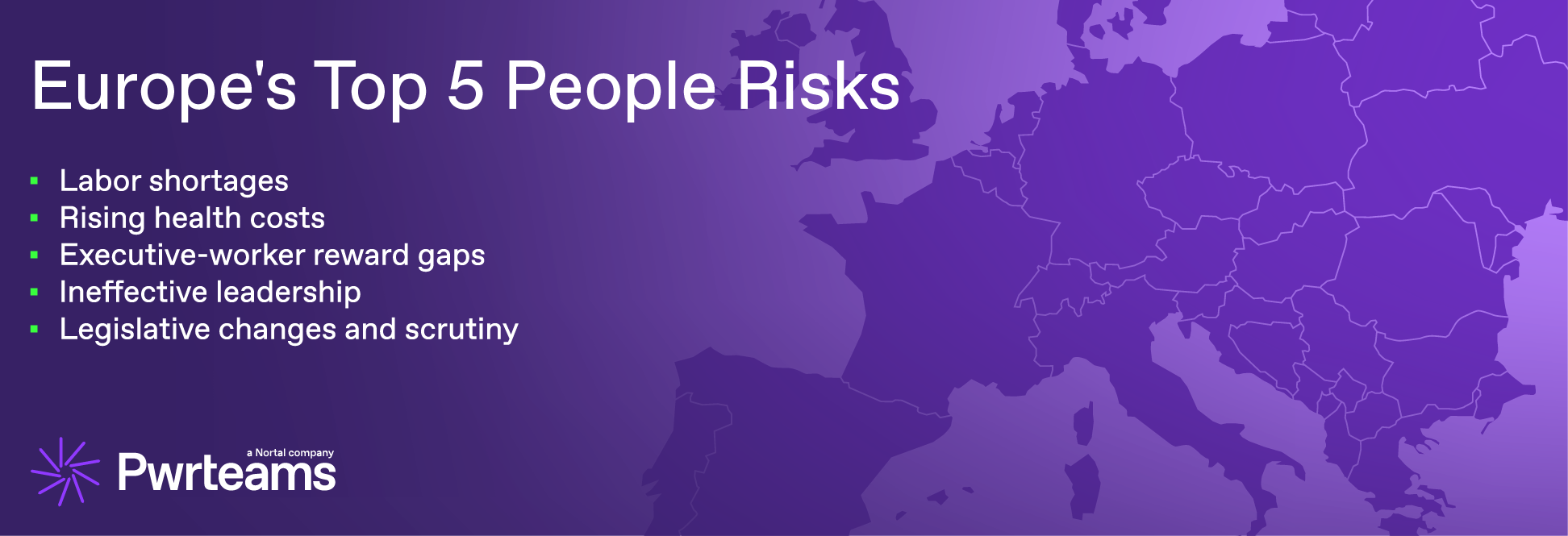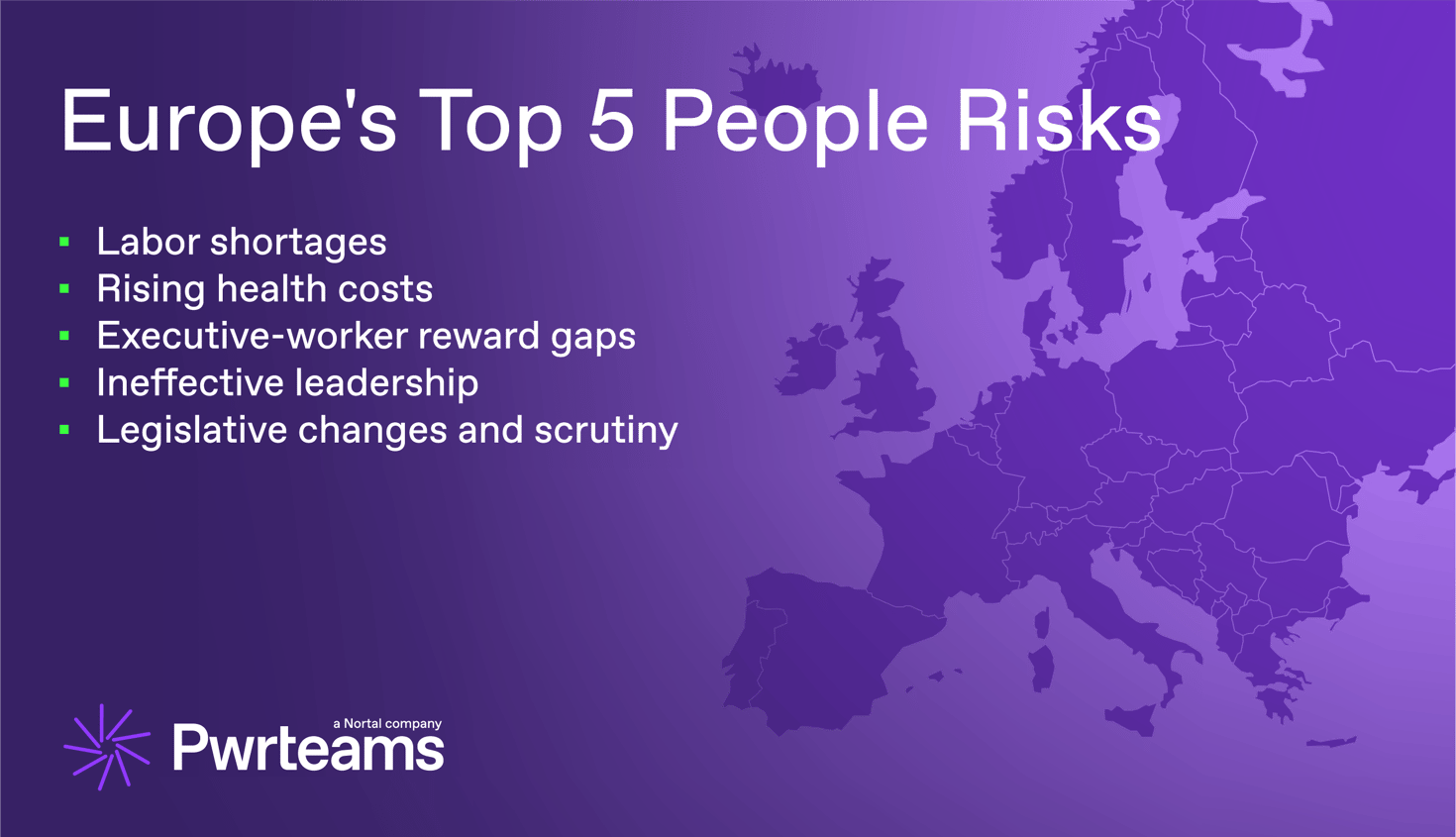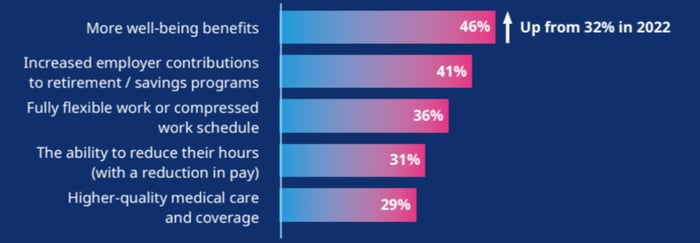Handling Europe's top 5 people risks: from labor shortages to legislative chaos


As Peter Lewyn Bernstein rightly noted, “The essence of risk management lies in maximizing the areas where we have some control over the outcome while minimizing the areas where we have no control.” And indeed, we can’t control inflation, predict the weather, solve housing issues, or fix international conflicts. But we can reduce their effect on our businesses. One effective strategy is a solid people risk management plan. It ensures we have the best, most motivated employees who stick with us for the long term, reducing the impact of these risks.
A recent People Risk report by Mercer Marsh Benefits identified key challenges HR and risk professionals face globally. Based on these and other findings, we’ve identified the top five challenges affecting people management in Europe.
Why Europe? Because that’s where many of our customers operate–and because we believe that some HR challenges and issues can be local, driven by regional geopolitics, economics, and migration. As such, it’s better to tackle them one region at a time. Join us in this journey as we explore these challenges and share practical tips and insights to turn people risks into people wins.
I. People’s risk in Europe 1: labor shortage
Why are labor shortages such a big deal in Europe right now? Recent reports from the European Union reveal that 74% of small and medium-sized enterprises (SMEs) struggle to recruit staff for at least one job role. The culprits? A mix of low birth rates, aging populations, the pandemic's lingering effects, and job quality issues.
The numbers speak for themselves. Since 2008, the EU has seen a steady decline in birth rates, with 4.68 million children born that year. In comparison, only 3.88 million babies were born in 2022. Fast forward to 2050, and a staggering 27% of Europe's population is projected to be past retirement age, compared to just 16% worldwide.
The pandemic threw another wrench into the works, cutting the average number of hours worked per person. Fewer hours worked means more people are needed to get the same amount of work done. The IT sector, in particular, is feeling the pinch, with higher skills shortages in the areas hardest hit by this drop.

Source: Eurostat
1. Too much work, not enough skilled people
As businesses scramble to find more workers to keep pace with their growing workloads, key tech specialists—like systems analysts, software developers, application programmers, and software and applications developers—are in high demand but critically short supply. Currently, the EU lacks 11 million ICT specialists to hit the target of 20 million working by 2030.
The IT sector is a rapidly changing industry. With groundbreaking technologies like artificial intelligence and cloud computing evolving at lightning speed, the demand for talented professionals increases. Not only do their skills have to match the employers’ requirements, but they also have to continuously update their knowledge to keep up with industry changes. And that requires much commitment.
This ever-widening gap between demand and supply in the IT sector presents a challenge for both sides: companies are in a desperate hunt for the right talent, while tech experts face the constant threat of obsolescence if they don't relentlessly upgrade their skills.
2. Job positions with the highest skills shortage
Even when a business finds candidates for a position, the challenge doesn't end there. In Europe, employers often struggle to find IT experts with the right skills to fuel their teams.
 Source: Europa.eu
Source: Europa.eu
3. Europe needs more skills
Across 21 European countries, 75% of employers reported difficulty filling job roles in 2023, up from just 42% in 2018. The biggest jump in talent shortage is noticeable in Ireland, the UK, Spain, and France, where the difference between 2018 and 2023 surpasses 50 percentage points. For comparison, the EU’s average increase is 34 percentage points.

Source: Euronews.com
Filling the gap with staff augmentationAs labor and skill shortages keep growing in Europe, businesses are getting creative to tackle the issue. When local talent is scarce, it’s time to look beyond borders. This is where staff augmentation comes in, helping you hire talented people with the right skills for your business needs. By adopting a staff augmentation strategy, you can effectively manage people management risks. Whether your business requires a single Java developer or an entire team of engineers and data analysts, an experienced staff augmentation partner will ensure the perfect skill match. Take our longtime client, TUI Group, where we've built a team of over 200 IT professionals through staff augmentation. Their ability to quickly scale and adapt to changing demands highlights the power of this approach in addressing labor shortages and keeping operations running smoothly. |
II: People’s risk in Europe 2: increasing health & benefits costs
For HR and risk specialists globally, increasing health and benefits costs top the list of risks. Europe struggles with this issue significantly, largely because of its traditionally generous employee health and benefit plans. While these comprehensive packages provide substantial support for workers, they also put considerable financial strain on employers.
In Europe, the cost of employer-provided health benefits varies widely. In Germany, employers pay around 14.6% of an employee's salary towards health insurance. In France, private healthcare insurance is a mandatory benefit, covered 50% by the employer. UK employers must cover National Insurance Contributions and auto-enrolment pension contributions that reach up to 16.80% of the gross salary.
In the Netherlands, employers pay mandatory social contributions, which include health insurance, sickness benefits, invalidity insurance fund, work resumption fund, unemployment insurance, and child care premiums. These costs can go up to 27% of an employee’s salary.
1. Work-life balance over higher salaries
No wonder employers in Europe invest in health and benefit plans. Employees prioritize healthcare support and well-being benefits over salary bonuses. 46% of employees said they would give up a 10% pay increase for non-monetary compensation.

2. People health and safety risks
Times are tough. The pandemic, inflation, political instability, and global conflicts all impact employees, affecting their performance and job satisfaction. Here are the top people risks HR and risk specialists find most disruptive in the workplace.
- Mental health deterioration
Europe is in the midst of a mental health crisis. Nearly 84 million people in the EU are grappling with mental health issues, costing the economy around 4% of GDP annually.
Depression and anxiety lower productivity, reduce attendance and raise healthcare costs. Addressing mental health is both a moral and financial imperative, as poor mental health can significantly increase labor costs and reduce efficiency.
Tragically, mental health is still considered taboo in many European countries. As a result, 50% of workers worry that disclosing a mental health condition could hurt their careers.
- Pandemics and infectious diseases
COVID-19 proved that a virus can turn the world upside down overnight. The isolation slowed down our economy but successfully sped up our mental health decline. According to the Health at a Glance report, the symptoms of depression doubled among young people in countries like Belgium, Estonia, France, Sweden, and Norway.
Viral diseases can hit workers hard, affecting everything from performance to revenue. With future pandemics possible, companies need to be ready. Quick adaptation and strong health and safety protocols are key to protecting the workforce.
- Healthcare system deterioration
The pandemic left the already strained healthcare system in shambles. Currently, Europe needs more than 2 million healthcare professionals. Overworked hospital staff leads to increased misdiagnosis and lower care quality. As a result, patients struggle to access needed public and private medical help, impacting workforce health and productivity.
- Unsafe physical and psychological working conditions
Nearly 23% of people have experienced physical, psychological, or sexual harassment at work. That's almost every fourth person! Toxic office cultures are just as detrimental to employees' well-being as hazardous work environments. When conditions are rough, morale drops, and eventually, people leave. High turnover rates impact work quality, decrease productivity, increase hiring costs, and damage the business's reputation.
- Chronic illness
Chronic illnesses like heart disease, diabetes, and respiratory conditions are on the rise, responsible for 74% of deaths in Europe. These conditions increase absenteeism and long-term health issues, increasing business strain. Chronic illness isn't just a personal battle—it's a workplace challenge, too.
III. People’s risk in Europe 3: disparities in executive/worker rewards
In European cultures, where status isn’t as big a deal as in places like Asia, you might think everyone’s getting a fair deal. However, executive vs. worker pay gaps are still a big issue. With the current economic crisis, this gap is getting wider. Employees are stressed about healthcare, retirement, and finances, while top execs rake in bigger paychecks.
This problem runs deep in Europe’s corporate scene, fueled by global hiring practices and fierce competition. To tackle disparities, we must dive into the root causes, dissect executive compensation structures, and explore the broader impacts on organizational health.
1. Explaining the pay gap
CEOs in the UK make 188 times the median earnings of typical full-time workers.
- Hiring foreign executives
European companies often bring in foreign executives, particularly from the U.S. and Canada, who don’t settle for price tags. While the base salaries of CEOs in the U.S. and Europe are similar, the difference is evident in long-term incentive (LTI) compensation. According to the WTW report, in 2019, U.S. CEOs earned about $9.4 million, with a staggering 72% of that tied to long-term performance achievements. Compare that to U.K. CEOs, who pocketed around $4 million, with only 46% coming from long-term incentives.
- Narrowing the gap with U.S. executives
Foreign executives bring compensation expectations based on their home country's market, often including higher base salaries, lucrative bonuses, and comprehensive benefits packages. Many European firms strive to narrow the compensation gap by making the compensation system more similar to the U.S.
2. The structure of executive compensation
CEOs are paid for their ability to drive company success, weather market storms, and shoulder enormous responsibilities. The pay structure is designed to reward long-term achievements rather than quick wins, ensuring they’re focused on the company’s future growth and stability.
- Base salary: This is the fixed, regular payment made to executives, often significantly higher than that of average workers.
- Bonuses: Executives receive annual bonuses based on company performance and individual achievements. These bonuses can sometimes equal or exceed their base salary.
- Stock options and equity: A major part of executive compensation comes from stock options and equity, aligning their interests with those of shareholders. This practice is designed to incentivize long-term performance and company growth.
- Perquisites and benefits: Executives often enjoy additional benefits such as company cars, private health insurance, and substantial retirement packages.
3. Negative impacts on organizational health
- Loss of motivation: when workers see such a stark pay gap, their motivation can take a nosedive. Feeling undervalued, they might slack off, thinking their hard work isn’t being recognized or rewarded.
- Rising frustration and resentment: big pay disparities can stir up frustration and resentment among workers, eroding workplace morale and job satisfaction. This can lead to higher turnover rates and a drop in productivity and innovation.
- Strained work relations: Pay gaps can strain relationships between workers and executives. When highly paid executives fail to empathize with their lower-paid employees, a divide appears, making it tough to foster a collaborative and cohesive work environment.
- Employee vs. executive tensions: in extreme cases, glaring pay gaps can lead to outright conflict, pitching employees against their bosses. This adversarial atmosphere can result in labor strikes, protests, and other disruptions, ultimately damaging the company’s reputation and bottom line.
We can help you design and implement compensation strategies that align with your organizational values and goals.
With our staff augmentation services, you get the best IT talent on the market in one package with expert management support. We ensure your staff's well-being, work satisfaction, and career development behind the scenes so you can count on them to carry your projects toward success.
IV. People’s risk in Europe 4: ineffective leadership
Ever had a manager who couldn't lead a meeting, let alone a team? You're not alone. In Europe, ineffective leadership is one of the key people's risks, especially in the fast-paced world of IT. What does it mean to be an ineffective leader? We expand on it on the next page.
Good leaders create a unified vision for their teams, know how to motivate their team members, and don't hesitate to act when a crisis arrives. Still, their leadership skills are insufficient without solid organizational fundaments and senior management support.

Source: Marsh.com
1. Traits of ineffective leaders
Ineffective leaders often exhibit poor communication skills, either over-communicating trivial details or under-communicating critical information. They lack vision, failing to provide a clear direction or strategy, which leaves their teams wandering aimlessly. Micromanagement is another hallmark of bad leaders, as they hover over their teams like aerial surveillance, stifling their innovation and independence. Thus, they struggle with delegation, trying to do everything themselves, inevitably leading to burnout.
Managers without empathy fail to understand or care about their team's perspectives. They discard any constructive criticism, often thinking they know best. Because they rely solely on their skills (or lack thereof), their decisions are inconsistent and erratic, causing confusion and frustration. This behavior only highlights their poor problem-solving skills, as they struggle to find effective solutions and often resort to quick fixes.
- Why the IT sector? Promotions are often based on technical expertise rather than leadership abilities, even though the best coder doesn’t always (or rarely) make the best manager. The rapid growth of the tech industry deepens this issue; companies expand so quickly that there’s often no time for proper managerial training. High demand for tech talent creates immense pressure to fill leadership positions. Companies need leaders yesterday, which leads to hasty promotions.
- How does it affect teams? Accidental managers struggle to motivate their teams, leaving employees feeling unsupported and less productive. When workers see their efforts undervalued, projects fail, and their concerns are ignored, they often decide to take their valuable skills and knowledge elsewhere, resulting in high turnover. Managers without formal preparation frequently fail to use their team members' abilities effectively, missing out on significant opportunities for innovation. This stifles creativity and impedes overall team performance and project success.
Don't let ineffective leadership derail your success. At Pwrteams, we deliver top-tier tech specialists and experienced tech managers who lead with vision, empathy, and clarity.
Take Televic Healthcare, for instance. Specializing in high-tech communication solutions for healthcare facilities, Televic partnered with us to build a dedicated R&D team. We found skilled developers, automation testers, and a project lead who could seamlessly connect the team.
With our help, Televic Healthcare built three new products, leveraging our experts' out-of-the-box thinking and unmatched tech skills. The result? Innovation, efficiency, and success—delivered.
V. People’s risk in Europe 5: changing legislation and scrutiny
To finish this guide in style, we'll take you through the labyrinth of European labor laws (taking the least confusing route), where changing legislation and heightened scrutiny keep companies on their toes.
1. The European labor law maze
- Retirement age:
Germany: 66 years; 67 (in 2031).
UK: 66 years; 68 (in 2046).
France: 62 years; 64 (in 2032).
Italy: 67 years.
- Probation periods:
Germany: 6 months.
UK: 3-6 months.
France: 2-4 months depending on the job position.
Italy: 3 months for non-executives, 6 months for executives.
- Paid sick days:
Germany: 6 weeks paid at 100%, after that up to 78 weeks paid at 70%.
UK: Statutory sick pay (£109.40) after 4 days.
France: 50% of salary, up to 3 years (waiting days apply)
Sweden: 364 days paid at 80%.
- Holidays:
UK: 28 days of paid annual leave a year.
Portugal: Minimum of 22 working days holiday per year.
France: 2.5 days for each month of actual work.
2. Adjusting to changes
Adopting new labor laws is not just a bureaucratic headache; it’s also a financial burden. The controversial IR35 Regulation in the UK has business owners tearing their hair out trying to make sense of disguised employees and the intricate distinctions between inside and outside IR35 statuses.
Companies must invest in legal advice, update HR systems, and sometimes even redesign their entire workforce management strategies. The costs can be substantial, but the price of non-compliance—fines, legal battles, and damaged reputation—can be even higher.
3. Always compliant with dedicated teams
At Pwrteams, we’re not just about providing top-tier tech specialists; we also ensure that you stay ahead of labor law changes.
Want to see augmented teams in action? See how they help companies in the UK stay IR35-compliant while offering specialized skills and flexibility from the vast IT talent pool.
VI. The risk-free empowerment of your teams
Labor shortages are leaving jobs unfilled, skyrocketing health costs are draining budgets, and pay gaps are sparking discontent among teams. Ineffective leadership leads people astray while changing labor laws don’t let business owners sleep at night.
While staff augmentation might not fix these problems overnight, effective team management will help you mitigate people risks and keep your workplace thriving.
With 17+ years of IT staff augmentation expertise, Pwrteams is your partner for top tech talent. Trusted by global leaders like TUI and Sitecore, we build quality cross-border teams that deliver.
Looking for experts on safe and secure hiring? Contact us, and we’ll help you build a team that prevails in every crisis.
 September 29, 2025
September 29, 2025
Build your team or extend with ours? Here’s what helps fintech CTOs decide
Read the post September 10, 2025
September 10, 2025
Fixed-price projects vs dedicated teams: A fintech CTO comparison
Read the post September 3, 2025
September 3, 2025
How burnout is crippling tech leadership in the Nordics and Benelux
Read the post September 29, 2025
September 29, 2025
Build your team or extend with ours? Here’s what helps fintech CTOs decide
Read the post September 10, 2025
September 10, 2025
Fixed-price projects vs dedicated teams: A fintech CTO comparison
Read the post September 3, 2025
September 3, 2025
How burnout is crippling tech leadership in the Nordics and Benelux
Read the postWrite your own
success story
with Pwrteams!
Share your details in the form, tell us about your needs, and we'll get back with the next steps.
- Build a stable team with a 95.7% retention rate.
- Boost project agility and scalability with quality intact.
- Forget lock-ins, exit fees, or volume commitments.